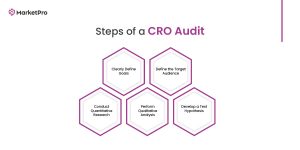CRO Audit: A Step-by-Step Guide to Improve Website Conversions
Aiming to tackle website usability issues with assumptions instead of data is like reading the packaging from inside the jar. It’s quite difficult for a company that has launched its own e-commerce site to grasp what the user interface appears to be for a new-to-file consumer.
Conversion Rate Optimization (CRO) necessitates an in-depth knowledge of how readers navigate and interact with your website. Conducting a comprehensive CRO audit is an important step in discovering broader website development issues and how to effectively fix them.
What is the Conversion Rate?
The conversion rate of a website indicates how many times a visitor accomplishes an objective divided by the total traffic on your website. If users can convert every time they visit (for example, by purchasing an item), divide the total conversions by the total sessions. When you offer a subscription, divide the number of conversions by the count of customers.
So, what is CRO? Conversion rate optimization occurs once the visitor comes to your website. This differs from optimizing conversions for organic SEO or professional PPC management, which is about who lands on a site via organic search results, the total clicks the site gets, and the keywords generating traffic.
What is a CRO Audit?
A conversion audit, also called a CRO audit, is a comprehensive review of the client journey on your site. The goal of an assessment is to detect technical or usability issues that may be impeding the rate at which visitors convert to buyers. A standard conversion audit examines the entire user experience while also delving deeper into a website’s metrics and reports.

The CRO Audit in 5 Simple Steps
CRO in marketing necessitates performing an audit to determine what negatively impacts the effectiveness of your conversion rate. This five-step guide covers the best way to carry out a conversion check on your website:
Clearly Define Goals
To get the testing process off to a strong start, individuals and teams should ensure that everyone is on the same page about what they expect to accomplish with a conversion assessment. The targets you choose may be influenced by a variety of aspects, such as the development stage of your brand, the performance of your website, and the long-term commercial goals.
A few desirable goals include:
- increasing conversion rate to make a purchase.
- Raising the average order value.
- Getting rid of shopping cart abandonment.
Begin by sticking to only 1-3 primary goals and ranking them in order of importance. Boosting conversion rates may be more important to the team than promoting email signups. Thus, determining where to focus your time and effort, as well as coordinating across the team and stakeholders, is a must.
Define the Target Audience
Emphasizing the intended audience is an important step in performing a successful conversion audit as you develop a website with their preferences in mind. Regardless of how you previously described your ideal client, it’s likely that the target demographic has evolved since the company created those customer personas. It is also likely that the “ideal” customer isn’t the one who shops in the online store. Examine the website statistics to determine the important demographic information. Determine who the consumers are, where they come from, and the items they’re passionate about on your website.
Conduct Quantitative Research
Focus on performing statistical analysis to figure out where problems are occurring in the customer journey to focus on those parts in the course of the optimization method. A technical evaluation should begin with a dive into analytics tools your company uses to identify bottlenecks in the path to purchase. Which certain web pages have an elevated bounce rate? Particularly major analytics tools make it simple to visualize the stages of the conversion funnel and determine where customers are most likely to abandon their journey.
Following an in-depth data analysis, one should have a firm grasp of two concepts: optimization domains and baseline measurements.
- The pages or portions of the website that can be optimized for a better consumer experience and promote your defined goals are referred to as optimization areas.
- Baseline metrics are indicators that show how your goods or site is performing on subjects that are essential to business today. (Advanced reports will show how those metrics fluctuate depending on the traffic channel, gadget category, landing page, or periodic variation.)
Perform Qualitative Analysis
When it comes to crafting a story with the analytics information that one has gathered, qualitative research is the way to go. Qualitative approaches such as testing users, session recording cataloging, evaluating eye-tracking heat maps, and building open-format questionnaires are all critical components of performing complete qualitative research. While statistics may indicate where the potential consumers are leaving, qualitative strategies will tell the why.
Develop a Test Hypothesis
Depending upon the pain points discovered in the qualitative and quantitative studies, it’s time to start thinking about what to test on the website to improve the customer journey. After reviewing the gathered data, one will begin to notice recurring trends and patterns in user activity. The research will reveal the particular spots on your website that are impeding conversion rates. Select one of them to delve into more. What could be done to increase the number of visitors at that stage of the client’s journey? Where should the metrics be when you regard the effort as a success? How to reach those targets? These test assumptions will serve as the foundation of subsequent A/B testing on the website.
CRO Audit Checklist
An audit of CRO in digital marketing must:
- Determine whether a CRO audit is required.
- Establish measurable objectives.
- Examine the target audience.
- Monitor user behavior.
- Evaluate channel traffic.
- Perform technical analysis.
- Conduct a heuristic analysis.
- Efforts to improve organic seo rankings.
- Perform routine testing and monitoring.
Get a Professional CRO Audit from Market Pro!
Customers are willing to spend more for a positive customer experience. So, if your website doesn’t give a terrific product experience, you’re passing up a significant potential to provide content that influences conversions. An efficient CRO audit is a crucial step in resolving customer issues and meeting company objectives. If you’re ready to hire professionals who facilitate data gathering and analysis, Market Pro offers conversion rate optimization services. We conduct a customer-oriented CRO audit to understand your audience’s needs, determine which areas of your site are driving conversions, and test potential adjustments. If there is any confusion, you can contact us, and our team of professionals will get back to you shortly.
Subscribe to get the latest offers, sneak peeks, and updates delivered straight to your inbox! See our Privacy Policy!







